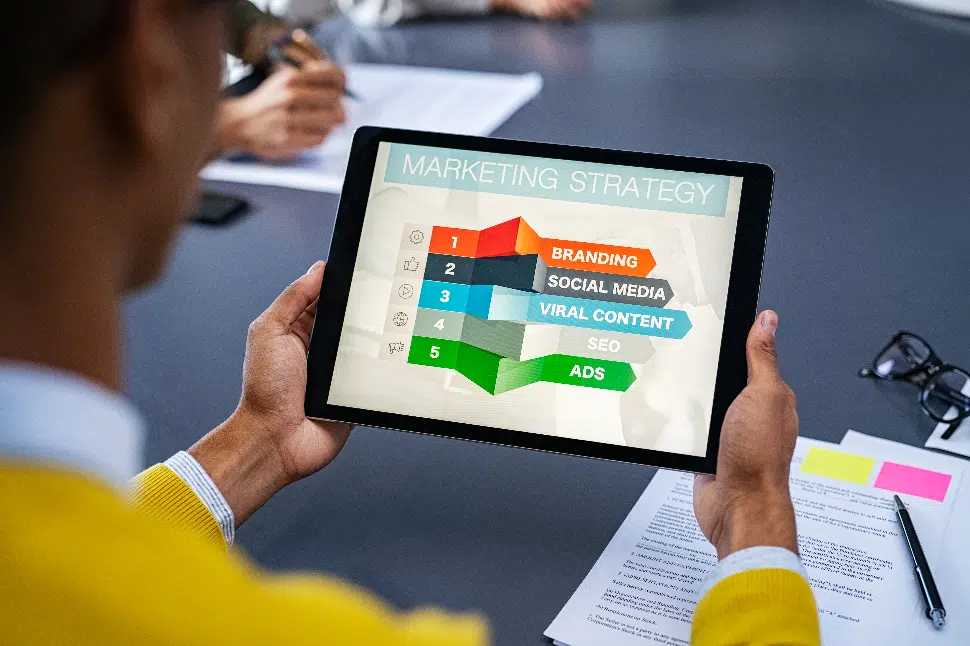At its core, advertising has always been—and always will be—a person selling to a person. But there is a dramatic transition that advertising has seen throughout history. That transition has been the spaces occupied by our promoting.
Today, a business that doesn’t include digital marketing as a part of their advertising strategy doesn’t stay in business for long.
So how can you target your paid ads for better results online?
Download our FREE Paid Ads Checklist
The Case for Paid Ads
Why is it important to include paid ads in this strategy? As it turns out, there are a number of reasons. First of all, they are targeted. You can control who sees your ads based on the analytics of your ideal customer. Another benefit is that you can adjust them to your needs. This might mean turning the ad off or on as needed. You can control how many people you are attracting by turning your budget up or down. Lastly, paid ads are fairly predictable. You budget for the ad campaign, and you get leads as a result.
But how do you avoid wasting your time on ads that don’t work? How do you prevent spending money on ads that don’t produce those leads?
Thankfully, there are a few simple ways to target your leads so that you can have the maximum increase possible.
Don’t be Overwhelmed by the Options
You don’t have to advertise on every platform
The good news? Among the dozens of platforms available, you don’t have to advertise on all of them. Paying for an ad campaign on every major social media channel doesn’t work. It means dividing your marketing budget among them all and gaining fewer leads per platform. And since social media isn’t the only outlet for promoting on the web, the slices of the budget pie get smaller and smaller.
When brands try to stretch their marketing efforts to too many places, their cost per click gets higher. Ultimately, the return on investment gets smaller. Of course, there is a good reason for this.
Different people use different features.
Consider your target market
When deciding which online platforms will gain the most leads for your brand, you need a clear picture of your target demographic. Hopefully, you already have an idea of your ideal customer. Give attention to which online spaces to focus your content marketing efforts. Keeping this in mind is crucial to getting your ads to work for you.
What does this look like from a practical standpoint?
When looking at search engines, Google appears to be king. Reports show that between 70-90% of internet searches take place on Google. Bing, on the other hand has 7-10% of internet searches.
With statistics like this, it’s no wonder that most businesses focus on optimizing for Google. However, when it comes to conversion rates, Search Engine Journal reports that Bing traffic has a 3.19% higher conversion rate.
Why is this?
The data shows the category of users who use Bing tends to be middle-aged and higher. Many of these people are homeowners. They are far enough along in their careers to have the budget to follow through on the home projects they are wanting.
While this doesn’t mean that all home service businesses should simply ignore Google as a means of gaining clients, it’s a good reminder. A business’s target audience should be considered when deciding where to spend money on promoting.
If you aren’t sure who your target market is, that’s going to be your first step. At Planify, we go beyond helping our clients choose an ideal age range, location, and economic status. We help you discover their philosophies, needs, wants, and way of life.

What spaces does advertising now occupy?
To help you identify where you want to advertise, it’s smart to measure the sort of media your customers are consuming. Do they spend a lot of time on social media? Do they use streaming pages? Are they fans of multitasking who enjoy listening to something while they do other work?
Having an awareness of your target audience allows you to narrow down these avenues of organic advertising. While this is by no means an exhaustive list, these are some of the most popular digital advertising spaces.
Social Media
There are constantly new players in the social media game, but a few stars have continued shining for quite some time.
Facebook’s users now span the generations, making it a notable choice for businesses in many industries. Facebook Ads have expanded so that building brand awareness is easier than ever. You can build an ad strategy for whatever your budget may be.
The downside to Facebook Ads is the level of competition and the fact that so many other companies are also promoting. For that reason, your ads need to stand out more than ever. (We’ll cover this in the next post in this series!)
LinkedIn is a fantastic platform for B2B brands seeking to provide a space that would be useful for business leaders. According to LinkedIn Marketing Solutions, marketers see conversion rates that are up to 2x higher than other platforms.
For e-Commerce websites, Instagram truly shines. While the generation using Instagram tends to be younger and less varied than Facebook, the gap has certainly widened. Instagram has been a leader in driving influencer marketing. In addition to buying ad space, many brands have also utilized popular Instagrammers to create new ad campaigns.
While these three seem to be the primary forces in social media marketing, there are a few other notable mentions. Twitter has proven a formidable option for advertising in certain industries, especially those related to politics and literature. Snapchat and TikTok are ideal promotion avenues for products that target younger clients and customers. And Pinterest is another excellent marketing tool for e-commerce websites and the creative industries.
Search engines
Of course, social media is not the only relevant tool where digital advertising is necessary. Search engines play a huge role in organic website traffic. For that reason, it’s important to note where your ad dollars will go the furthest.
As previously mentioned, Google is the most utilized search engine. Google also has the benefit of having an excellent business suite where companies are able to set up their entire digital office. At Planify, we deem Google’s business tools valuable enough that it’s one of the primary services we offer to our clients.
It may come as a surprise to those who view it as a global marketplace, but Amazon is actually a search engine as well. It provides traffic to businesses who utilize it well. Not only are you able to offer your products via Amazon, but you can take advantage of Amazon as an advertising platform. This may open the doors to excellent customer awareness and new leads.
Bing, of course, we have already discussed. It’s a targeted resource for those wanting to advertise on a platform that reaches a more stable demographic. It’s a great choice for many brands, even if it has fewer users than Google.
Visual Media
The benefit of visual media can’t be understated. There is something so powerful about seeing a product demonstrated in a 30-second story. Luckily, you no longer have to pay millions of dollars for a TV spot to show it.
YouTube is the king of easily accessible visual media. Anyone can post a video and channels range from makeup artists to homesteaders to, of course, businesses. But aside from leveling up your brand to having a YouTube channel, there is also the chance to advertise on YouTube directly. YouTube Ads play at the beginning or middle of monetized videos. Channels who want to make money off their content are required to include ads as a part of their business model. This works well for businesses who are looking for a way to market their product or service through a commercial-style internet ad. If you feel that your product is best highlighted through a video, this could be a possible route to generate leads.
Recently, Netflix announced their addition of ads for many of their subscribers. It may seem risky to spend your online advertising budget on something new like this. However, it is certainly worthwhile to track the performance of this ad space. Take note of other companies who create ads for this market and decide if it could improve your brand’s performance as well. If it seems worthwhile, run a short-term test with your ad.
Hulu is another streaming network that includes ads for some subscribers. Again, this is a relevant site if you feel that your product should be seen in an active setting. It’s helpful if you want to use video marketing as a method of promoting to a vast number of potential customers.
Audio Media
Spotify’s ads allow companies to share audible advertisements while users listen to their favorite songs and playlists. This is an option for those who feel their clients like to listen while doing other things. Or it could be those clients who might be too busy with other things to sit and watch a show.
Pandora is quite different from Spotify in that users are able to discover new music that is similar to the genres they prefer. These users may have a more easy-going personality or be more adventurous. This is important for companies to recognize when deciding where to place their ad budget. They want to be sure this is in line with their target customer.
Podcasts are another space for your audio advertising, given that many podcasts are sponsor-supported. The key to this is finding a podcast that relates to your field. For instance, a start-up finance magazine could advertise on a finance-related podcast. Likewise, a business selling high-quality wooden toys might want to market to listeners of a parenting podcast.
Importance of Intent
Your customers have certain avenues where they are more likely to click on ads. Their intent is a key point of determining where that might be.
As you can see from the list above, users have different intent when using each of these advertising mediums. While not every client is going to fall into the same demographic, understanding your customer is extremely necessary. There is another method of researching which of these specific mediums would perform best. Try to analyze in the entertainment styles your target audience prefers.
Passive Inspiration
Customers who rely on passive inspiration spend their time on social media channels, where they can scroll and interact as they desire. This is considered more of a newspaper style medium. For customers who tend to use these mediums, your advertising dollars are best aimed toward Facebook, LinkedIn, and Instagram.
Start thinking about content campaigns that would stop a user from scrolling and make them click. What specific images or text would stand out?
Active Research
Maybe you have clients who are aware of what they want, and they make calculated decisions in that search. If so, your digital advertising dollars are best spent on the catalog sites, such as Google, Bing, and Amazon.
Create an ad that is brief, but has enough information to inform the consumer. Let them see that your page is the one they should click. Set your brand above the other results of their search.
Active Entertainment
An audience who seeks out active entertainment are often those who are stressed. They need to get away from the real world for a while. Otherwise, it could be those who have too much time on their hands and get easily bored. This is where YouTube, Netflix, and Hulu are an advertiser’s best friend.
Reach out to your ideal client by creating a visual experience. Design an exciting ad or commercial targeting viewers.
Passive Entertainment
Passive entertainment is best for potential customers who like to multitask by listening while they are on the go. This could be a housewife cooking and relying on an audiobook or a businessman driving to a meeting with Spotify on in the background.
Ensure good, consistent tone of voice in your ads or a jingle that will stick in their heads…without irritating them.

Where Does Your Service Fit?
Ultimately, we match these categories with our target customer to determine where to spend our advertising budget.
Once you know where your ideal client likes to spend their time, you can make the decision where you need to focus your funds.
Of course, there is more that goes into making your digital ads work for you.
Keep an eye on the Planify blog for the rest of our series on paid ads. Our next focus, on the core elements of a paid ad, just might be your missing link to digital advertising success.

